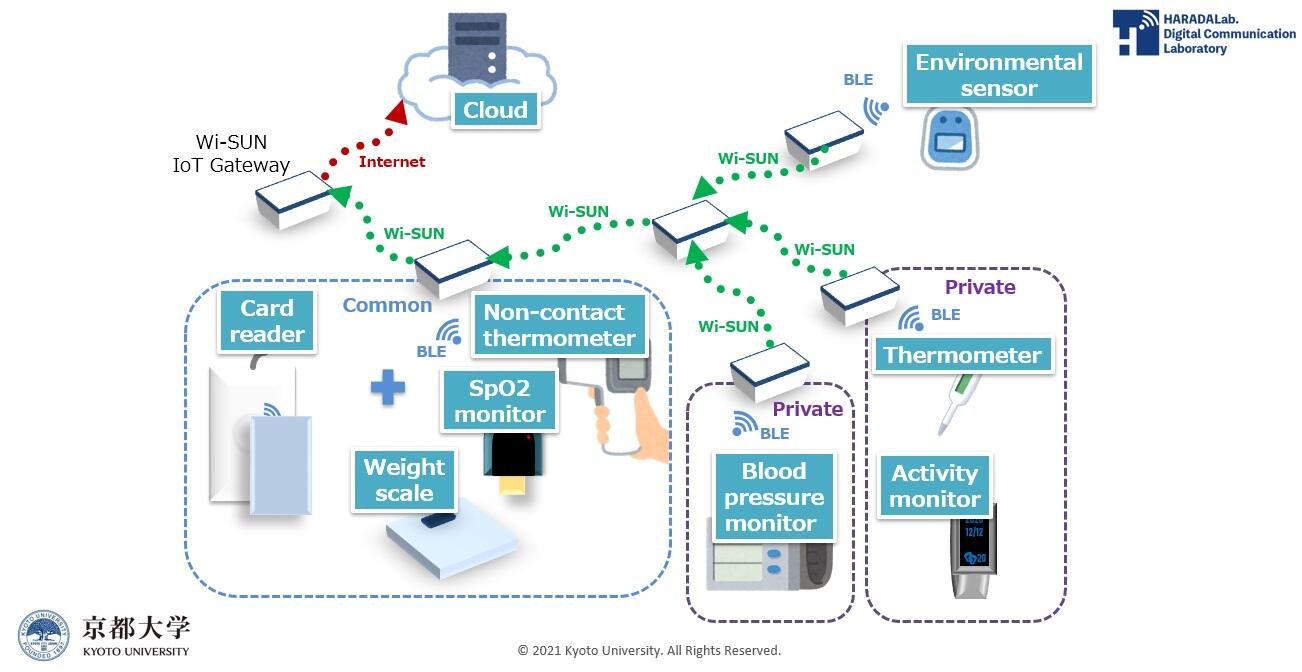On 26 April, Professor Hiroshi Harada's research group at Kyoto University Graduate School of Informatics announced that they have developed a new gateway for IoT applications equipped with the international wireless communication standard Wi-SUN FAN, which is expected to serve as a communication standard for next-generation smart meters. Furthermore, using the developed IoT gateway, they have developed an application that relays biometric and environmental data in multiple stages via Wi-SUN FAN and transmits them to the cloud. The application has been successfully demonstrated via an experiment at the local medical institution. This IoT gateway is scheduled for commercial application by the end of May and is expected to to be priced at tens of thousands of yen.
Wi-SUN is a license-free wireless communication standard, with a low power consumption, introduced in the smart meters of electric power companies. It is one of the LPWA methods for connecting IoT devices and can be used for communications for distances ranging from 500 m to 1 km using radio waves in the 2.4 GHz band and 900 MHz band (sub-gigahertz band). This technology was developed mainly by NICT (National Institute of Information and Communications) and is standardized by the international organization IEEE.
Wi-SUN FAN (Field Area Network), which employs this technology, is a communication specification established by the Wi-SUN Alliance, an international non-profit organization consisting of manufacturing vendors and software companies. Furthermore, with IPv6 installed in sensors and meters to realize smart cities wirelessly, multi-stage relays (multi-hop, where radios relay data without a base station) are possible. Version 1 was established by the Wi-SUN FAN Working Group in May 2016, and version 1.1 is currently being standardized for high-speed communication and low power consumption.
Kyoto University and Nissin Systems Co., Ltd., in collaboration with Rohm Semiconductor, developed the world's first Wi-SUN Alliance certified radio using Wi-SUN FAN in 2019. Professor Harada of Kyoto University was a co-founder of the Wi-SUN Alliance in 2012 and has been active as the chairman of the Wi-SUN Alliance Board of Directors for many years. Professor Harada has endeavored to formulate technical specifications and disseminate the Wi-SUN system for home smart meter systems used by electric power companies. Recently, the research group of Professor Harada and others has developed an IoT gateway equipped with the Wi-SUN FAN wireless communication function. It is equipped with Wi-Fi and Bluetooth as standard, has a number of interfaces, and runs on standard Linux. Therefore, various applications can be developed by providing a development environment, and it can be used for research as well as commercial use. Furthermore, the research group has developed and installed an application that relays biometric and environmental data to this IoT gateway in multiple stages via Wi-SUN FAN and transmits them to the public cloud. This application has been successfully demonstrated at the Kyoto University Hospital via an experiment.
The application supports the connection of six types of BLE biosensors (thermometer, sphygmomanometer, activity meter, weight scale, blood oxygen concentration meter, and non-contact thermometer), a BLE environment sensor, and a USB card reader. Furthermore, the application can be installed using a USB memory device and updated via the Internet.

This demonstration experiment was conducted in a mobile container-type PCR laboratory (clinical room) that is isolated and installed in the parking lot of the same facility by the St. Marianna Association to prevent nosocomial (healthcare associated) infections during outpatient examinations for the novel coronavirus disease. To avoid contact between people, five IoT gateways were used to collect various data such as body temperature data, blood pressure data, blood oxygen concentration, temperature, and humidity from each private room in the container with Wi-SUN FAN. The data was relayed in multiple stages and transmitted to the public cloud. Measurement data was encrypted, and personal information not included. Professor Harada explains the advantages of the developed IoT gateway, stating, "Since only the last IoT gateway is connected to the Internet, the communication fee is based only on this last gateway, and the Wi-SUN that connects the gateways is free of cost. The gateway can also be powered by a smartphone battery and can also acquire and store logs and Wi-SUN transmission information, and thus, large-scale demonstration experiments with a wide range of IoT gateways can be conducted."
This article has been translated by JST with permission from The Science News Ltd.(https://sci-news.co.jp/). Unauthorized reproduction of the article and photographs is prohibited.




